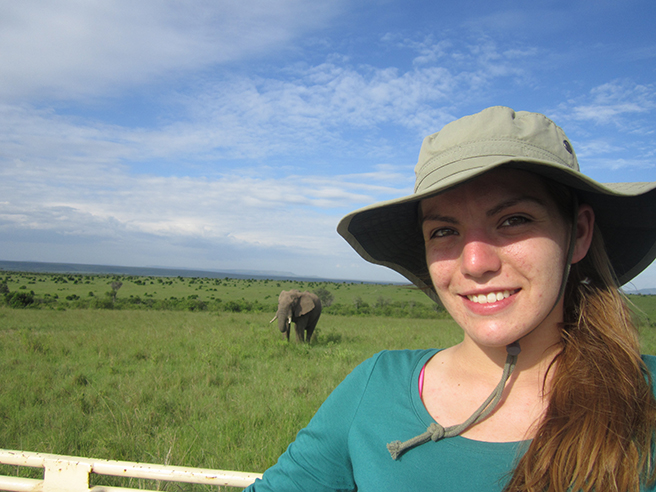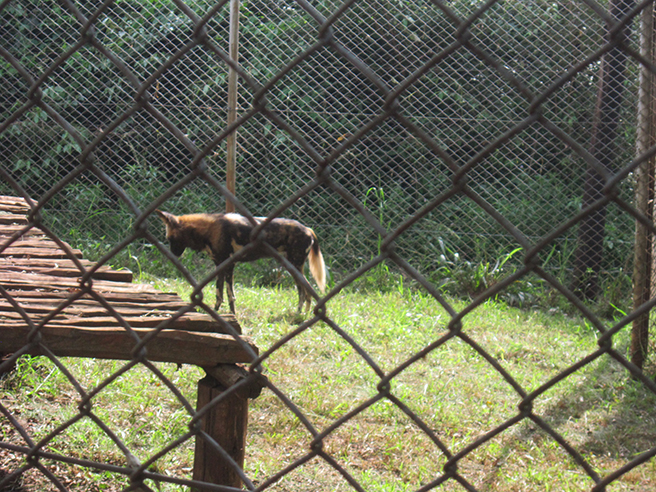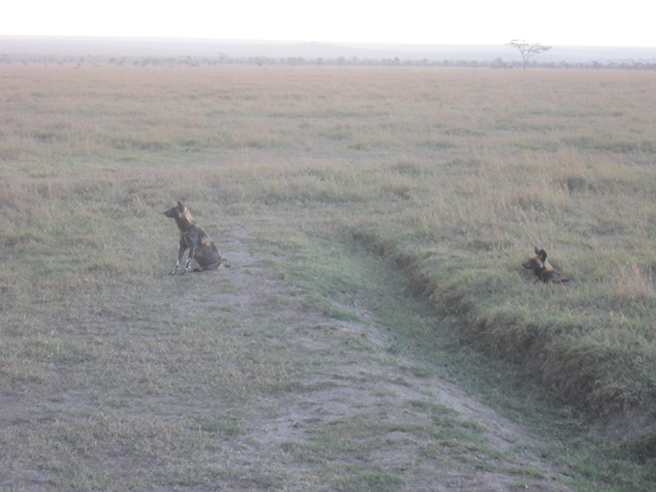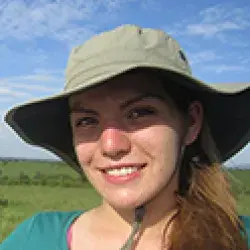Love at First Sight: Andrea Meets an African Wild Dog

I was a naïve, bubbly college freshman – out of my element and in a brand new place for the very first time. He was shy and graceful, with a cautious air about him that seemed to shelter a young, playful spirit. He caught my interest without even trying. I was captivated by the line of his shoulders, each careful step he took, and every tilt of his delicate head. He was breathtaking, and I couldn’t tear my gaze away. It was love at first sight.
As a proud, self-proclaimed animal nut and a stereotypically know-it-all teenager, I was sure that my nineteen years of near constant exposure to the likes of Animal Planet and Discovery Channel had taught me everything I needed to know about the African ecosystem. I considered myself a pro regarding lions, leopards, cheetahs, and zebra, and I could describe the differences between Thompson’s and Grant’s gazelle with ease. When I learned of the opportunity to study abroad in Kenya with George Mason University’s Center for Global Education, witnessing firsthand the marvels that I had admired for years through my television screen, I couldn’t sign up quickly enough. You can imagine my astonishment when, not even a full day into the sixteen day journey, I was confronted with a creature that was entirely foreign to me. Gazing into the chain-link enclosure of the Kenya Wildlife Service’s Wild Animal Orphanage, I couldn’t help but admire the beautiful creature before me.

The African wild dog, or perhaps more appropriately “Painted Dog”, is a sleek, lean specimen. Like others of its species, the orphan had a narrow body with long gangly legs, and a somewhat scruffy coat dappled with a seemingly random assortment of black, tan, and white splatters. Each individual has a long bushy tail ending in a white tip probably designed as a communication device during hunting activities. When the orphan rose and turned towards the watching crowd, I recognized perhaps the most endearing feature, the oversized ears that stuck out of his head like small satellites, giving him an almost comical appearance. If that wasn’t enough, the timid creature suddenly flipped and proceeded to wriggle around on his back playfully, just like the precious pets I had left at home. I knew then that I was a goner.
Upon learning of the rarity of seeing my new favorite species in the wild, I was obviously disappointed, but contented myself with the brief view through chain-link fencing. After all, it would seem that that was as close to a “wild” dog as I was ever going to get. Oh how wrong that assumption turned out to be. The very next day, bumping through the Samburu Heartland on our first game drive of the trip, we just so happened to spot the tell-tale ears I had grown so fond of not ten feet from the road we were travelling. Excited beyond belief, I was literally bouncing in my seat at the sighting. Then a member of my party pointed towards a small dip in the landscape. All we could see were the small, white tips of the tails bobbing crazily over the rise, but immediately I knew: there were pups. We had somehow stumbled upon a den! One of my companions had to remind me to breathe.

“You are a lucky group!” Our driver, Julius, exclaimed with his signature, hearty chuckle, “Yes, a lucky, lucky group!”
I smiled appreciatively at the good-natured Kenyan man before turning back to the precious sight before me. In that moment, I knew that nothing could possibly top this sighting. Life was perfect.
As is often the case, a huge black cloud quickly moved in to ruin my perfect picture. I soon learned that the fantastical creatures that had stolen my heart were headed for a not-so-happy storybook ending. Often viewed as a villain by the human population, African wild dogs have been persecuted to serious endangerment in retaliation for depredation of livestock. Seeing the predators as a threat to their livelihoods, farmers and ranchers have killed so many animals that there are less than 5,000 remaining in the wild, and populations continue to decline.
Desperate to reverse or at least halt this downward spiral, the African Wildlife Foundation makes a point of trying to reach out and educate populations in conflict with wild dogs while simultaneously finding ways to make coexistence an easier option. Efforts include the hiring of twelve scouts from local communities whose job it is to collect data regarding everything from pack movements to attacks on livestock. GPS tracking collars fitted to seven dogs from three packs allow scouts to alert local ranchers when a group is in the area, hopefully allowing them to make proper adjustments and prevent the loss of cattle to the skilled hunters.

One particularly interesting revelation gained from the collected data is the noticeable link between the health of an area’s ecosystem and the number of depredation events. Researchers have found that wild dogs tend to prefer natural, wild prey and generally only go after livestock as a last resort. If an ecosystem is healthy, the natural prey population is more stable, and fewer attacks on livestock occur. Though many of the areas set aside by the Heartland program do not encompass a pack’s entire hunting range, they do protect many of the prey species that these predators rely on so heavily. In doing this, AWF may not ensure that the dogs will be safe from their persecutors, but it does provide pockets of relief and stability in the species’ rapidly deteriorating world.
Going into this trip, I worried that there would be too much emphasis on conservation of plants and habitats rather than examination of species conservation. I realize now that I was foolish to separate the two. If there is one lesson that I have taken away from this trip, it is that all conservation a closely intertwined. If one does not strive to preserve the plants and microorganisms that form the basis of a natural habitat, then there is no hope for a healthy animal population. On the reverse side, without animals setting changes in motion, the overall health of the system is sure to deteriorate. While this presents quite the intimidating task, I have also found that people from all walks of life are striving to protect and preserve the incredible environment that has been entrusted to us. Working together, I know we can make a difference.
This is a guest blog from George Mason University's Kenya Ecology and Conservation course with instructor Ryan Valdez. The students stayed at the research centre of the Ol Pejeta Conservancy while in Africa and visited AWF's headquarters to learn about conservation and share their experiences.
